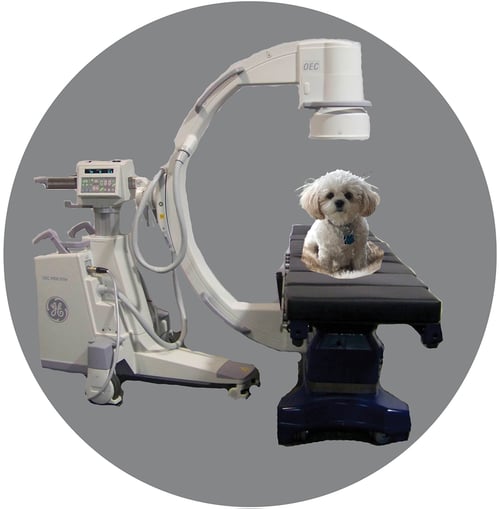The level of care for pets has improved dramatically in recent years. Many tests and diagnostic techniques used on humans are now available for use on animals. Fluoroscopy is one such diagnostic tool that is being used by veterinarians.
techniques used on humans are now available for use on animals. Fluoroscopy is one such diagnostic tool that is being used by veterinarians.
Fluoroscopy is a kind of advanced medical imaging that lets veterinarians view the inside of a pet’s body while it is in motion. Similar to an X-ray, fluoroscopy provides multiple images instead of just one. This technique captures motion in real time, somewhat like an X-ray movie. By producing multiple images, it’s easy to view the structure and function of organs to identify abnormalities or issues.
A fluoroscopy machine in a veterinary clinic usually includes a main body unit that’s connected to a C-arm unit. The C-arm unit extends around where the cat or dog is positioned on the table.
The patient sits or stands inside a plastic box on the table, with the box positioned within the two sides of the C-arm. Then, the X-ray beam is targeted at the animal. The imaging team will coax the dog or cat to do different things during the exam in order to get images from different positions. The C-arm and the main body unit move in tandem alongside the dog or cat to adjust to the height and location, based on its position and size.
Fluoroscopy is used to visualize body systems like the heart, digestive system and respiratory system. With fluoroscopy, one can view the motion that occurs when an animal breathes or swallows, allowing one to see abnormalities that occur, food as it moves from the esophagus and into the stomach and how the wind pipe changes shaped when air passes through. This enables the vet to diagnose and/or monitor any disorders.
If a veterinarian is performing a swallow study for a pet, the pet will be placed in the box. During the fluoroscopy, the dog will be fed a variety of food mixtures, including dry kibble, semi-formed soft food and liquids, each containing a contrast materials that will be illuminated during the exam. This is helpful in identifying and diagnosing Reflux disease, Esophageal Motility disorders, Epiglottic abnormalities and even issues with airways.
You might think that a C-Arm might be financially out of reach for your veterinary practice. However, a refurbished or used C-Arm is much more affordable and still comes with a great service warranty and the performance you need. The experts at Atlantis Worldwide have been helping healthcare providers find the right medical imaging solutions for more than 30 years and would love to help you.
Follow Atlantis Worldwide on Twitter: @AtlantisLLC
Other blogs you may have missed:
- C-Arms - The Perfect Tool for Veterinarians
- C-Arm Warranty & Service Contract: What is Included?
- Should your business lease or buy medical imaging equipment?
- X-Rays & Dogs: What you should know
- Your C-Arm Is Arriving - Is Your Facility Prepared?
Meet the author: Vikki Harmonay



